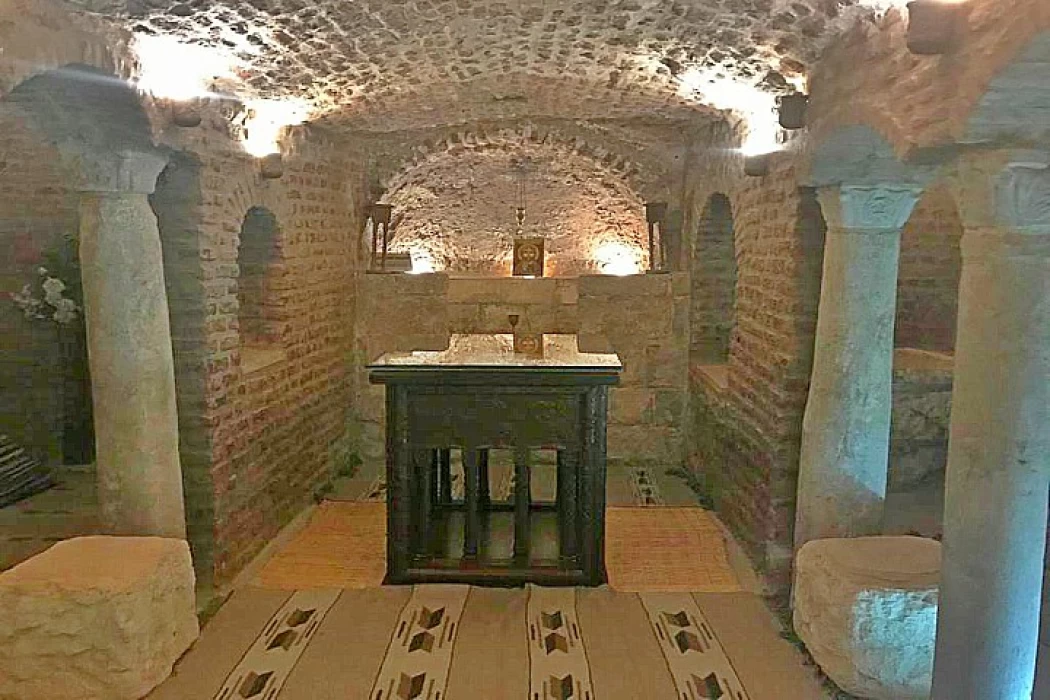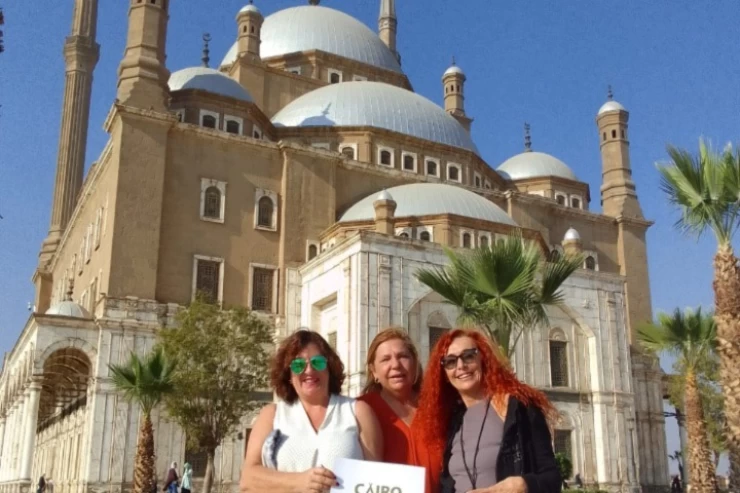
Jesus' Footsteps in Egypt: The Holy Family's Journey Through Egypt
The Holy Family route in Egypt
The Holy Family's sojourn in Egypt is a journey of faith and a world heritage celebrated by Copts and venerated by Muslims. The entry of Mary, Joseph and Baby Jesus into Egypt is a major Christian festival.
In Egypt, some forty sites have been identified as being part of the route taken by the Holy Family, from the wells used to quench their thirst to the caves that sheltered them, as well as the many monuments and churches built in memory of their passage.
The exegetes agree that the trip to Egypt probably lasted more than two years. According to the text of Matthew, Herod was not immediately informed of the birth of Christ. Reason why he ordered the massacre of all children under two years of age.
Among the milestones is Matarieh, near Cairo airport, where the Holy Family is said to have been sheltered by a sycamore tree when Herod's henchmen were about to overtake them. In this sanctuary, where Christian and Muslim women go to pray for children, is a balsam garden irrigated by the spring in which the Virgin Mary is said to have washed her infant's swaddling clothes.
Another landmark is the church of Maadi, built on the Nile at the point where the gold, frankincense and myrrh offered by the Magi enabled Joseph to take his family upriver. At Sakha, in the Delta, a stone is venerated as bearing the imprint of Jesus' little foot.
The final stopover would be on Mount Qosqam, 330 kilometers south of Cairo. The monastery of Deir Al-Moharraq is built on the site of the house where the Holy Family is said to have stayed. It was here that Joseph, warned in a dream of Herod's death, sent his family down the Nile to return to Galilee.
In the year 1 BC, Gabriel, the angel of the Lord, appeared to a fiancée, betrothed, whose name was Mary, to preach to her the birth of a son named Jesus.
Of course, the angel realized that her fiancé, Youssef El-Naggar, would be suspicious of this issue, so he also appeared and assured him.
It was clear that the sky was busy with this birth. With these two, a vision appeared for three kings from Persia and foretold them of the news; an angel appeared to one of the rabbis of the Jews and preached the birth of his son named John the Baptist, and he foretold that this would be a sign of the birth of Jesus.

The Torah was full of ancient prophecies talking about the details of this birth, its location, what the kings will give this child, and his journey to the land of Egypt, as well as the madness of the king who will lead to this journey.
The family did not settle in one place, so there are many monasteries and churches, and this is documented through religious sources and rare manuscripts in Coptic monasteries and churches in Egypt, adding: “The trip ranged from a week or a few days in some cities, and in others, it settled a month and the longest period in Qasqam Mountain Who is in the city of Assiut now and spanned 185 days.
After God commanded the Virgin to escape her newborn from the oppression of Herod, heading to Egypt, there were 3 known commercial and war routes that a traveler could take at that time, avoiding the known methods and choosing unknown paths, and the journey that split into three stages.
They crossed the Nile to the west at Desouk and headed south to Beheira Governorate until they reached Tarana near Khattabah, then Wadi El Natrun in the wilderness of Shihit, where 500 monasteries were built, including four of them, Saint Abu Makar, Anba Bishoy, Alsaryan, and Braamos, they crossed the Nile south until they reached the charitable barrages.
Then the march included a direction to Al-Matariyah and Ain Shams, which was inhabited by 2000 Jews the family rested under a sycamore tree and there witnessed a miracle that Christ took the stick on which Joseph the carpenter leaned and broke it into pieces and then planted and put his hand on the ground so the water spring and the balsam extracted from which balsam oil is extracted It has a smart smell, and the remains of the well and the tree are still there inside an open museum called the Mary Tree Museum,
and there are the remains of the tree and have names for the soldiers of the French expedition who registered it after recovering from purulent ophthalmia, after washing their face from the water of the well, and also there is the provider in which Christ was washed.
Then the family headed to the Zewaila Gate and the Hanging Church with a water well, then they went to the ancient Roman fortress of Babylon, where the archaeological Church of Abu Serga, known as the two martyrs Sergius and Wajis, then installed the Nile complex for Maadi, where the Church of the Virgin is now.
The journey lasted two years, six months, and ten days, and the family returned from Qusiya to Maadi, then to the Babylon Fortress, where a cave was located at the bottom of the Abu Sergius Church, then north to Musturod, then to Belbis, then Qantara, then to Palestine, via Gaza, and finally settled in Nazareth. Churches, and considered tourist attractions.

The Church of Abu Serga is one of the important stations where the Holy Family settled in the Babylon Fortress, after taking refuge in Egypt to escape the oppression of the Roman ruler in Palestine.
Historians confirm that it is the oldest church in ancient Egypt, and indeed in all of Cairo. The Holy Family passed through the same location where it was constructed. The grotto where the Holy Family slept during their flight to Egypt is located there.
Holy Family Church in Matariya: The Holy Family took the road east of the Nile, and Herod's soldiers came from west of the Nile and came to Matariya while leaving Egypt and not while entering... In the church, there is an amazing statue representing the size of Jesus Christ. When he was in the Matariya area, he was five years old.

The Holy Family traveled from Bethlehem to Gaza to the Zaraniq (Falsiyat) reserve, 37 km west of Al-Arish, and entered Egypt via the northern side of Al-Farma (Balusium), located between the cities of Al-Arish and Port Said.

The precise amount of time the Holy Family stayed in Egypt has been disputed by historians, but Coptic tradition describes it as more than three years and just under four years.
The Journey of the Holy Family to Egypt Pope Theophilus, the 23rd Patriarch of Alexandria (385–412), decided his decree during the Ninth Coptic Week of 1999 that "the journey from leaving Bethlehem until returning to Nazareth is three years and six months, which is consistent with the estimate that the Holy Family will remain in Egypt for nearly two years, and the rest has departed on the journey of coming and returning."

The Holy Family serves as an excellent model for families worldwide to always be receptive to God's will and to constantly listen for His voice. He might speak his will in prayer or through another person. By our own prayer and discernment, we too can follow God's lead for our life.

Latest Articles
Admin
Aswan Governerate in Egypt
Aswan was known as ‘Sonu’ in ancient Egyptian times, meaning market, as it was a trading centre for caravans coming to and from Nubia. In the Ptolemaic era, it was called ‘Sin’ and the Nubians called it ‘Yaba Swan’. It was also known as the Land of Gold because it served as a great treasure or tomb for the kings of Nubia who lived there for thousands of years. Before the migration, Aswan's borders extended from Asna in the east to the border of Sudan in the south, and its inhabitants were Nubians, but after the Islamic conquest of Nubia, some Arab tribes settled there.
Admin
About Luxor Governorate in Egypt
The South Upper Egyptian area is home to the Egyptian governorate of Luxor. Its capital is Luxor, which was formerly Thebes, the capital of Egypt throughout multiple pharaonic eras. Its centers and cities are spread over both sides of the Nile River. The said governorate was established by Presidential Decree No. 378 of 2009, which was promulgated on the 9th of December of that year.
Admin
History of kafr El Sheikh Governorate
Kafr El Sheikh Governorate, located in the far north of Egypt in the Nile Delta, overlooking the Mediterranean Sea, is characterised by the diversity of natural life and environments, and is one of the Egyptian cities that can be visited after the end of the first semester exams at universities and schools, as it features many diverse tourist and recreational places at symbolic prices within everyone's reach.
Admin
Egypt's New Administrative Capital
The New Administrative Capital is considered the project of the era because it reflects a perfect image of the future and progress on the economic, cultural, social and civilisational level, as the capital is considered the new capital of Egypt at the present time. The importance of the New Capital is that it is a comprehensive transformation of the future of buildings, services and national and mega projects in Egypt.
Admin
Al Gharbia Governorate
The Governorate of Gharbia is inclusive in the geographical area of The Arab Republic of Egypt which is in the African continent, more specifically in the region surrounding the Nile delta, between Damietta and Rashid governance. To the control of the region from the north is Kafr El-Sheikh Governorate, from the south Menoufia Governorate, from the east – Dakahlia, Qalyubia Governorates, and to the west is the Beheira Governorate.
Admin
Hamata Islands (Qulaan Archipelago) in Marsa Alam
Each reserve has several sectors. In Wadi El Gemal Reserve, there is one of the natural areas called the Hamata area or Hamata sector in Wadi El Gemal Reserve. Its sectors are the perfect and most ecological, land and water, and host countless animals and plants found in the oceans and on the land.














